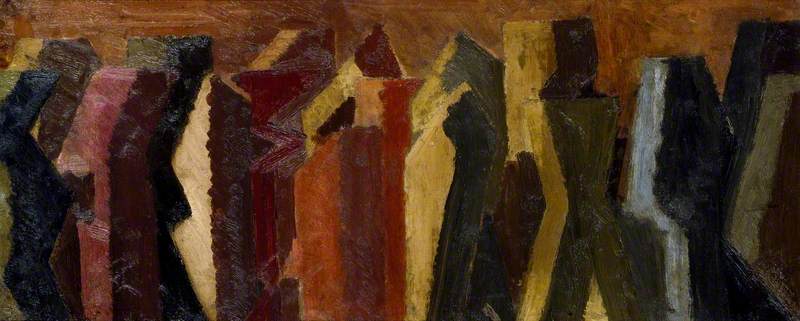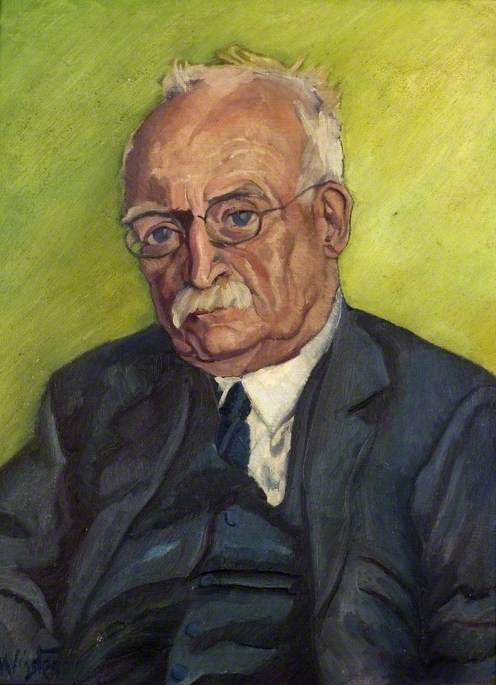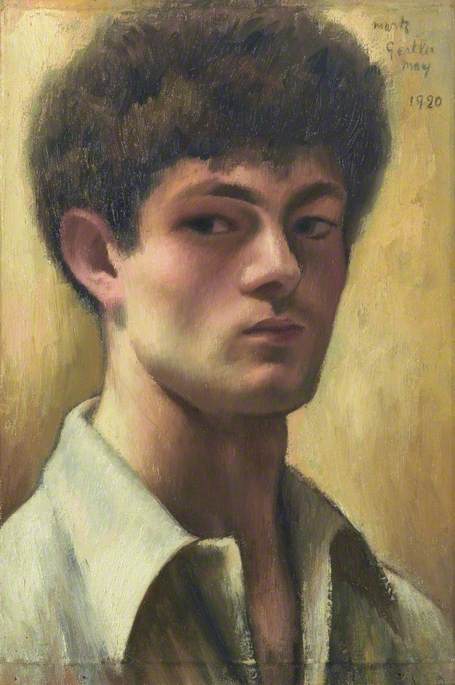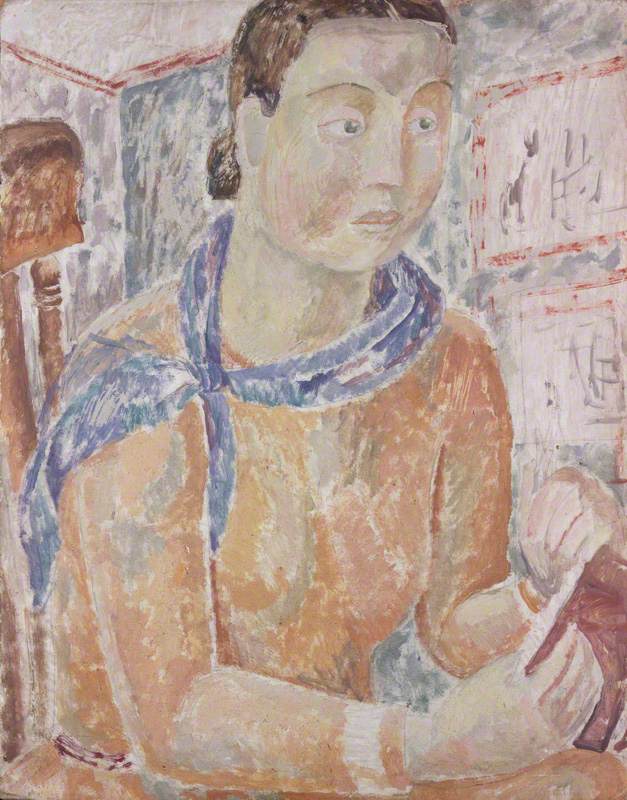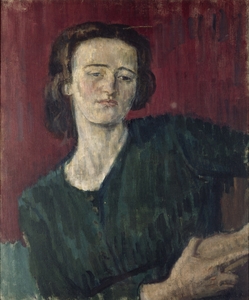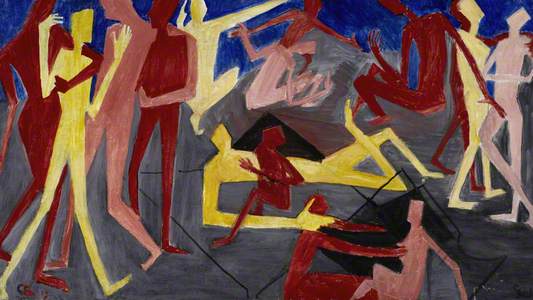On 8th May 1914, a few short weeks before the Sarajevo assassination that sparked the First World War, the Whitechapel Art Gallery opened as their summer show 'Twentieth Century Art: A Review of Modern Movements'. This was to be received as a pivotal exhibition of new directions in art, with the featured artists – from Bloomsbury, the Slade and elsewhere – then working in some of the more progressive Post-Impressionist styles.
In the Upper and Lower Galleries, the artworks were grouped into four sections according to their source of influence – for example, the followers of Walter Richard Sickert (1860–1942), Pierre Puvis de Chavannes (1824–1898) and Paul Cézanne (1839–1906) – and arranged in visual styles (to a greater or less extent) often described as Cubist, Futurist or Vorticist.
Additionally, in the Small Gallery, there was a special display of works categorised by the ethnicity of their creators, many of whom came from the surrounding district, which since the 1880s had been increasingly populated by emigré Jews fleeing persecution in Europe.
This 'Jewish Section' comprised some 54 works by 15 artists, and celebrated what was later described by the Yiddish translator and critic Joseph Leftwich as the 'Yiddish ferment in the East End'. It was curated by sculptor Jacob Epstein (1880–1959) and David Bomberg (1890–1957), the latter a young local artist expelled from the Slade only the year before for his radical aesthetic. Bomberg's work at that time was associated with the near-abstractions of the so-called Rebel Art Centre (some of which were on display in the Lower Gallery).
In addition to Bomberg, who selected six of his own works including his 1912 Vision of Ezekiel (no. 255), many of the artists in this section were recipients of study grants from JEAS, the Jewish Educational Aid Society. These included Isaac Rosenberg (1890–1918), Bernard Meninsky (1891–1950) and Morris Goldstein, who each submitted five works, and Mark Gertler (1891–1939) whose striking portrait of Golda, The Artist's Mother, was one of seven of his works displayed.
Other participating artists included the slightly older Alfred Aaron Wolmark (1877–1961), who had two paintings featured, Jacob Kramer (1892–1962), whose four weighty subjects included Life, Death, and Human Nature, and Mark Wayner (Weiner), who had one painting and would later establish a reputation as a caricaturist.
An older Kensington artist, Hubert Schloss, showed one work in this section and one in the Lower Gallery and Australian artist Horace Brodzky (1885–1969), then exhibiting with the London Group, included five. The section also included Jewish artists based overseas: Moïse Kisling, Jules Pascin (1885–1930), Elie Nadelman and Amedeo Modigliani (1884–1920), whom Bomberg and Epstein had met on a visit to Paris the previous year.
The only woman to have her work exhibited in this group was Clara Birnberg (1892–1989) (later Clare Winsten), also a Whitechapel resident and fellow Slade student. At one time she was romantically involved with Bomberg, and she too experimented with 'Vorticist' works, like her Untitled 1911 piece – though she later complained that her 'freedom of mark and inspiration' had been 'taken' by Bomberg, and resented him for it.
Birnberg was born in Romania, shortly after her parents Michael and Fani Birnberg left their native Ternopil, in Ukraine, and travelled to England via Germany. They arrived in London when Clara was around eight or nine, and her father found work initially as a cabinet maker, and later as a manufacturer of underclothing. The small family of five (with her brother Jonas and sister Gezela) settled in St Mark's Street, in Goodman's Fields.
From 1900, Clara attended Central Girls School in Spital Square, later winning an LCC scholarship to the Royal Female School of Art in Queens Square, Bloomsbury (which in 1914 merged with the Central School of Art and Design). The family were naturalised in 1911, a year after Clara, 'on the strength of her promise', transferred to the Slade School of Art, to study under Henry Tonks.
Birnberg was also the only woman in the loose association of local artists and writers now often referred to as the 'Whitechapel Boys', though their friend Clara Klinghoffer (1900–1970) also had cause to be included in this group. As well as Bomberg, the group included Gertler, Rosenberg, Goldstein, Meninsky and Kramer.
The Whitechapel show was the only time the group exhibited together. The critic Joseph Leftwich was also associated with the group, and he later recalled his vivid memories of the Jewish East End, the writers and poets John Rodker and Lazarus Aaronson and a young teacher, Samuel, or 'Simy' Weinstein, who later adopted the name of Stephen Winsten. Both Clara's and Simy's fathers were part of the intellectual group of the East End, while others, like Gertler's parents, remained very much apart from it.
Simy Weinstein and Isaac Rosenberg had been close friends since childhood, as pupils at the Baker Street Board School in Stepney. Simy later described them as like 'Siamese twins', recalling that Rosenberg was 'a favourite of the school' who would often make the illustrations for their history and poetry lessons:
'He was given drawing paper, he was given books and the moment he arrived he was given nice sharp pencils... here was this boy loving literature, making poetry, making drawings... in a district where the main interest was fighting.'
The close friendship later extended to Birnberg and Rosenberg who created some fine reciprocal portraits. Clara also made three pencil studies of him in 1913–1915 (now in the UCL and British Museum collections).
New blog post! Newly-discovered portrait of Joseph Leftwich by
— British Portraits (@UBPnetwork) December 21, 2016
Clare Winsten c1919, by @SJMacDougall @BenUriGallery https://t.co/cJul7MnBTr pic.twitter.com/WTvoY9b5z8
Some of the more politically active members of the group (Rodker, Rosenberg, Leftwich, Winsten and Bomberg) were members of the radical Young Socialist League, which was formed in 1911, and supported the Bolsheviks. Simy's elder brother had contact with Vladimir Lenin and he recalled accompanying Lenin to various events in London in 1904.
Clara herself joined the Women's Freedom League and became active in women's suffrage, something she had been interested in at least since her fourth form when she declared at a school debate: 'One honourable member spoke so well that we think she ought to be an MP.'
The various members of the Whitechapel group lived and worked closely together, enjoying a fertile cross-pollination of ideas and friendships. Goldstein and Rosenberg regularly walked the three or so miles from their homes in Whitechapel to the Slade in Gower Street, to save on fares, and they, and Bomberg and Rodker all fell in love with Sonia Cohen, a local seamstress whom Rodker later married. After the war, Jacob Kramer's sister Sarah married his Slade friend William Patrick Roberts (1895–1980), and Simy Weinstein and Clara Birnberg reportedly married in the middle of it, in 1916, and their daughter Theodora was born the following year.
As war was declared, Weinstein, a confirmed pacifist whose brother had been sent to Siberia for refusing to fight in the Russian army, joined the No-Conscription Fellowship, as did Gertler and Rodker, and he and Birnberg spent much of 1914–1916 campaigning against conscription. Goldstein was unable to enlist owing to his not having been naturalised, so took up a teaching post as Art Master at nearby Toynbee Arts Club.
Meanwhile Gertler fled to Garsington in Oxfordshire, long a centre for the 'Bloomsberries' and their associates, where Lady Ottoline Morrell supported him by the provision of farm work, and he continued to paint throughout, though often in darker mood. Others of the group volunteered or were called up as the machinery of war rolled fatefully on.
Bomberg's Procession of 1912–1914, a formal study of figures in sombre religious progress, seems almost to presage the lines of conscripts marching to their slaughter.
Rosenberg's Self-Portrait in Steel Helmet, drawn midway through the war, shows the artist anxious yet curious about himself in uniform. Bomberg himself found the situation on the Front unbearable. Serving in Flanders with the Royal Engineers, he temporarily invalided himself by shooting himself in the foot, for which he underwent the army's unforgiving 'Field Punishment No. 1' – which meant being restrained in chains to a fence post for up to two hours each day.
His experiences in war were to bring a profound change in his artworks, which did not sound the right 'tone' – his Sappers at Work: A Canadian Tunnelling Company, Hill 60, St Eloi, commissioned for the Canadians' Memorial exhibition, was criticised as a 'Futurist abortion'.
Study for 'Sappers at Work: A Canadian Tunnelling Company, Hill 60, St Eloi'
c.1918–19
David Bomberg (1890–1957) 
At home, Gertler's Merry-Go-Round, inspired by a fair in Hampstead Heath, reflected in the imaginations of many the brutal cycle of violence, and since regarded as one of the most famous 'anti-war' paintings.
Weinstein was imprisoned several times as a 'conchy' in Wandsworth, Bedford and Wormwood Scrubs. In an interview recorded in 1976 (in the IWM) he describes a fellow inmate, a former butcher, giving his reason for refusing to fight as 'I know what it is to kill a pig, I will not kill a man' – a stance shared by Weinstein and no doubt reinforced by the death of his close friend Rosenberg at the Somme in April 1918. He was released in 1919 under the 'Two Year rule' while his friend John Rodker alternated between prison sentences and hiding out in London 'on the run'.
During the war year, in July 1915, the Russian-Jewish émigré artist Lazar Berson founded the Ben Uri as the 'Jewish National Decorative Art Association (London)', at Gradel's kosher restaurant near Aldgate East Tube station. It went on to collect and promote Jewish artists, providing financial assistance and later gallery space for many, including those who had exhibited in the 1914 Whitechapel show, mounting exhibitions like its 1946 Subjects of Jewish Interest at its gallery, then in Portman Street.
The theatres, and Passmore Edwards Library and the Whitechapel Art Gallery had long provided focal points for this intellectual and artistic circle. Bomberg, Gertler and Kramer frequently found in their shared Jewish culture a cherished source of inspiration for their artworks, as indeed it continued to be for later artists.
Some, like Clara Klinghoffer, came to resent what they saw, as far as their art was concerned, as an artificially 'alienating' label of Jewishness or 'exoticism' (applied by an often casually antisemitic press), while Gertler found himself impossibly torn between the vibrant culture of his Whitechapel boyhood and the lure of the art world which lay beyond it.
Bomberg's post-war Ghetto Theatre gives some sense of the intensity of feeling at that time. On his return, he felt unable to live in the East End, and other artists, like Gertler, also had moved away, even while retaining strong emotional ties to the area.
Despite having exhibited in the Whitechapel's 'Jewish Section', Clara, with her husband Simy, subsequently renounced Judaism, and became Quaker Humanists, changing their name to the more English sounding Clare and Stephen Winsten. They remained heavily engaged in politics and social life, and over the years Clara made many portraits of their friends and acquaintances, such as the Iranian Bahaist preacher ʻAbdu'l-Bahá on his visit to London in 1911, the 'garden city' planner Sir Ebenezer Howard (c.1927), Mahatma Gandhi (1931), and W. H. Auden (1960).
During the Second World War, they lived briefly in Huntingdonshire, where Simy took work as a teacher and Clare continued to paint. Later they moved to Ayot St Lawrence in Hertfordshire, where the Winstens were neighbours with the Fabian playwright, socialist and 'Quaker of sorts', George Bernard Shaw, with whom they forged a close friendship. Stephen Winsten wrote extensively on Shaw, and Clara made of him many fine studies and portrait busts, such as her 1949 pencil portrait now in the National Portrait Gallery.
It is for her portraits of Shaw that Clare Winsten is now best known. She also illustrated several works including his Buoyant Billions: A Comedy of No Manners in Prose (1949) and My dear Dorothea; a practical system of moral education for females... (written when Shaw was 21 and posthumously published in 1956).
‘The vote will never be won by speeches made by men on behalf of women… The speaking must be done by the women themselves.' - George Bernard Shaw. There is a statue of St Joan, female suffrage icon, at @ShawsCornerNT. #Votes100 #WomenandPower https://t.co/5Y52Ge9bDm pic.twitter.com/PYho3Qqm9S
— NTBooks (@NTBooks) February 6, 2018
A replica of Clara Winsten's now destroyed bronze statue of St Joan, inspired by Shaw's most critically acclaimed play which helped win its writer a Nobel Prize, stands today at Shaw's Corner, a testament to their friendship.
Sara Ayad, independent art researcher










